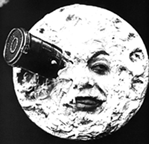 File this in the time-worn dumb science article category.
File this in the time-worn dumb science article category.Owing to the position of the moon in the night sky tonight, i.e. close to the horizon, it's going to appear larger than it normally appears to us. Whenever this happens, we get a rash of boilerplate articles like this one claiming that the moon will appear "unusually large," which is an "illusion."
I hate to break it to the new kid with the journalism degree who got stuck at the science desk, but the moon really is friggin' enormous. Aside from distant galaxies, so far away that they appear to the naked eye as single weak stars, or aside from the stars themselves and our solar system's other planets which also appear as no larger than stars, the moon is the largest object we can ever see. It's the only huge object close enough to us that we can begin to have any sense of its scale at all, and in fact almost all of the time it appears ridiculously small.
At human scale, which directly affects and dictates our perception of size, the moon is so large that we can barely comprehend an object of that mass. The numbers have intellectual but little perceptual weight; nothing in daily human experience prepares us, or has evolutionarily prepared us, to think about the actual size of the moon compared to, say, a hoagie. The illusion is that we have any sense at all how big the moon might be, the illusion is the inkling that the moon is ever in any way "small" compared to anything we can experience through our appropriately-scaled senses. The horizon-hugging moon is a tiny correction of our drastic misperception.
As the great Carl Sagan would say, we're limited by our scale as small creatures on the Pale Blue Dot...


No comments:
Post a Comment